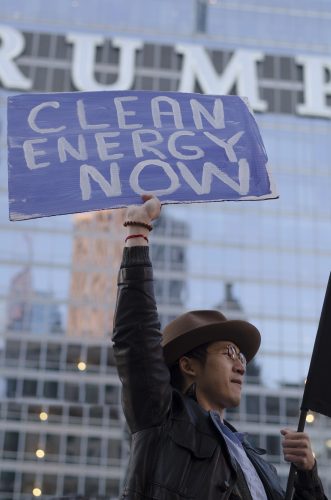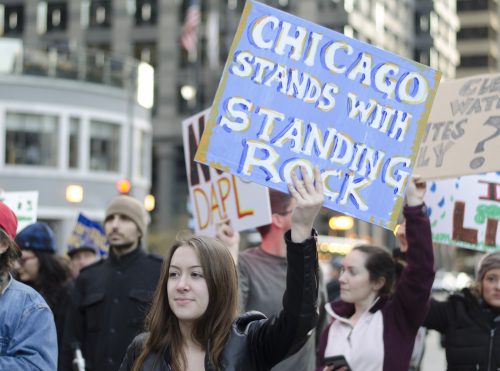On Dec. 4, 2016, the water protectors at Standing Rock rejoiced when the Department of the Army announced that the Dakota Access pipeline (DAPL) would not continue in its original path towards the Mississippi River.
The Dakota Access pipeline was formed in hopes of helping the U.S. achieve energy independence, and to transport oil underground instead of by rail. Once completed, the pipeline would transport 470,000 barrels of crude oil each day. The company said that the construction of the pipeline would create 40 permanent jobs and up to 12,000 temporary jobs.

The $3.7 billion pipeline was announced June 25, 2014, but didn’t come into the public eye until 2016. At that time, the pipeline was 87 percent complete and construction was about to start near the Standing Rock Sioux reservation. This was considered to be a major threat to the Sioux tribe since the pipeline was infringing on their right to the land.
“I didn’t know until really late in the (construction) that it was happening,” Bri Schwartz, a dramaturgy student at DePaul, said. “I feel awful about it as someone who wants to do social justice work. But that’s the media, and that’s how much of a play it really has.”
Protests took place not only on the Standing Rock reservation, but all across the country for the environment and the right to have clean drinking water. Not only would the construction of the pipeline force many Native Americans to relocate, it would break the Treaty of Fort Laramie of April 29, 1868, which gave them the land in the first place after being forced out on the Trail of Tears. This is still a possibility, which has been going significantly unnoticed, since there has been no final decision on the matter, the construction is only on halt.
Currently, construction on the pipeline has been halted while an alternate route is found, but this is a short term victory since president-elect Donald Trump and his administration have the power to decide the fate of the pipeline’s future. For this reason the disappearance of NoDAPL from mass media does not mean the battle is over.
“Native Americans are still treated so poorly today, and to treat them even worse by trying to build a pipeline on their sacred ground is sick,” Francesca Pedersen, a directing student and environmental activist at DePaul, said. “We would not build a pipeline through a church. How is this any different?”
When the halt was announced, Jo-Ellen Darcy, the assistant secretary for Civil Works said, “The best way to complete that work responsibly and expeditiously is to explore alternate routes for the pipeline crossing.”
This is a victory for the Sioux tribe, but the battle is far from over. With the state of the pipeline not set in stone, there is too much at stake to not speak up. Not only will the Sioux tribe be catastrophically impacted, so will the future of our environment.
Most media outlets have stopped their coverage on the pipeline since the victory. With nothing set in stone, the water protectors of Standing Rock are worried and protests are continuing to surface to get media attention.

On Jan. 1, 2017, two Dakota Access pipeline protesters hung a banner from the roof of the U.S. Bank Stadium during the Minnesota Vikings and Chicago Bears football game.
U.S. Bank has extended a $175 million credit line to Energy Transfer Partners, the Fortune 500 gas and propane company in charge of Dakota Access, LLC.
The protesters climbed the rafters of the stadium and hung a banner from the ceiling that read “Divest” and “#NoDAPL” to urge the many financial backers of the pipeline to drop out and to bring the pipeline back into the mainstream media.
“I’m not gonna find anything about Standing Rock in the newspaper,” Pedersen said. “I go (to) sources from people who are actually there and people who are reporting live from there.”
The two protesters, along with a third possible protester, were arrested and then released from jail with charges of trespassing and burglary pending. Many people are mixed about the stunt, including Evan Moore, an adjunct professor at DePaul and journalist.
“The Bears and Vikings at this stage in the season aren’t very good teams, and it was the last game of the season. I thought those protesters would’ve picked a better time,” Moore said. “However, the stunt got people talking. A lot of the beat writers at the game tweeted about what they saw. It worked.”
Since the halt on the pipeline was announced in the last weeks of the Obama administration, the fate of Standing Rock is in Donald Trump’s hands. Considering Trump and his cabinet have openly disregarded the harsh realities of climate change, the first 100 days has the ability to completely destroy the Sioux tribe and the environment at large.
Trump has invested between $500,000 to $1 million in Energy Transfer Partners, and his cabinet pick for the Department of Energy, Rick Perry, has previously served as the director of Energy Transfer Partners.

With his plans to undo many of President Obama’s environmental and climate change policies — protesters are demanding that people pay attention to the state of the pipeline.
But Trump has gone back on many of his policies since becoming the president-elect, and people are not sure which side of this issue he will be on come Jan. 20.
“Yes, during the election cycle Trump said he wanted to undo many of the things President Obama put in place,” said Moore. “However, he has backed off on some of those things he said while stumping for votes. He said he wanted to ‘Drain the Swamp,’ but many of the people he has appointed to cabinet positions are career politicians.”
As the inauguration moves closer be prepared to see more from protesters. With the media taking a focus on the president-elect, there is all the more reason for activists to make their voices heard and shift the conversation.
“Civil disobedience needs an audience to disrupt the status quo,” said Moore. “What better way to do that by going to what Americans seem to love the most (…) football.”







